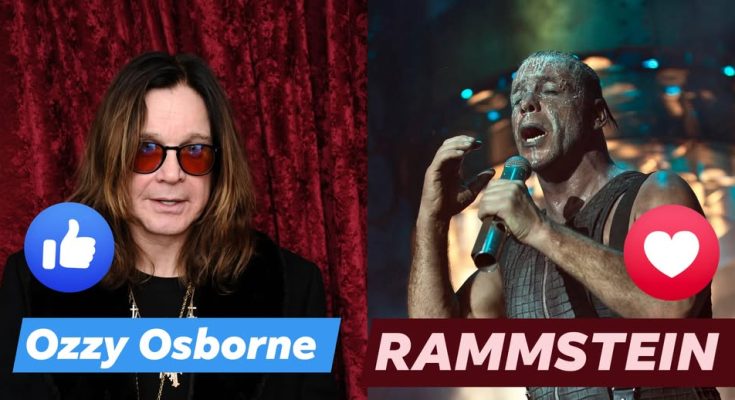The world of heavy metal thrives on power, theatrics, and pure energy — and few names embody that more fiercely than Rammstein and Ozzy Osbourne. When these two titans stand in contrast, fans are witnessing more than just a musical comparison; they’re witnessing two eras, two philosophies, and two visions of what it means to be a legend. On one side, Rammstein — the industrial powerhouse from Germany, defined by their fire-breathing shows and mechanical precision. On the other, Ozzy Osbourne — the “Prince of Darkness,” whose journey from Black Sabbath to solo stardom carved the very foundation of modern metal. Both stand tall, yet their worlds collide in a storm of power, rebellion, and timeless artistry.
When Rammstein emerged in the mid-1990s, their sound immediately carved a niche in the landscape of rock and metal. It wasn’t just heavy — it was surgical, deliberate, and shockingly theatrical. Their 1995 debut album Herzeleid announced a new era, one that fused pounding industrial beats with German lyrics that were as poetic as they were provocative. The band’s frontman, Till Lindemann, became an icon of controlled chaos — part poet, part pyromaniac, part prophet of the dark stage. Meanwhile, Ozzy Osbourne had already become a myth. His work with Black Sabbath in the early 1970s laid the groundwork for everything that followed. Paranoid, Iron Man, and War Pigs didn’t just define heavy metal — they created it. And when Ozzy struck out on his own, with albums like Blizzard of Ozz and Diary of a Madman, he reinvented himself once again, crafting an image that was both terrifying and strangely endearing.
So what happens when the paths of these two forces — one rooted in industrial machinery, the other in classic darkness — collide? You get a cultural conversation that transcends generations. Both artists have challenged norms, flirted with controversy, and reshaped the identity of heavy metal for their respective audiences. Ozzy Osbourne, known for his wild antics — from biting the head off a bat to his unpredictable stage presence — embodies the spirit of unfiltered rebellion. He’s chaos in human form. Rammstein, in contrast, represents discipline and spectacle. Their concerts resemble a militarized art performance: fire, metal, and rhythm combined in perfect, terrifying harmony.
Yet, beneath these differences lies a shared soul. Both Ozzy and Rammstein speak to the outsiders, the misunderstood, and those drawn to the darker corners of the human psyche. Ozzy gave a voice to the alienated youth of the 1970s and 80s, channeling frustration and fear into anthems that felt both dangerous and liberating. Rammstein, decades later, spoke to a new generation — one immersed in digital alienation, political disillusionment, and a world that felt mechanical and detached. Their music, from Du Hast to Deutschland, taps into the same primal emotion that fueled Ozzy’s early masterpieces: the need to rebel, to confront the absurdity of existence, and to find power in chaos.
When Rammstein and Ozzy are mentioned in the same breath, the discussion often centers around who represents the true essence of heavy metal. But that’s not the right question — because they represent two sides of the same coin. Ozzy’s raw, human unpredictability made metal emotional; Rammstein’s cold precision made it cinematic. Ozzy’s music was haunted by demons both literal and personal, while Rammstein’s art explores the psychology of modern man, blending brutality with philosophy. Ozzy sings of madness as something to escape; Rammstein embraces it as an inevitability.
In live performance, this contrast becomes even sharper. Ozzy’s concerts are a communion — chaotic, unscripted, alive with improvisation and interaction. The fans chant, scream, and join him in a collective exorcism. His charm lies in his humanity; even at his most unhinged, Ozzy feels approachable. He laughs, swears, and howls, like a mad prophet who invites you to join his gospel of chaos. Rammstein’s shows, meanwhile, are operatic and apocalyptic. Flames burst, mechanical platforms rise, and Till Lindemann commands the stage like a dark general. Every move is choreographed, every sound perfectly placed — yet it still feels primal and dangerous. It’s not chaos; it’s control masquerading as destruction.
Thematically, both artists explore darkness but from vastly different perspectives. Ozzy Osbourne’s darkness is personal — addiction, loss, fear, and redemption. His songs often reveal a man wrestling with his own inner demons, a mirror to the human struggle. Rammstein’s darkness, by contrast, is societal. They hold a mirror to the collective — to power, lust, nationalism, and hypocrisy. Where Ozzy asks, “Am I going insane?”, Rammstein asks, “Is humanity already insane?” Both perspectives are essential to the evolution of metal — one inward, one outward, but both honest in their depiction of chaos.
Over the years, Ozzy has become a symbol of resilience. Even as age and illness have challenged him, he remains the embodiment of metal’s indestructible spirit. His mere presence on stage today feels like a victory over time itself. Rammstein, on the other hand, continues to reinvent the boundaries of live performance. Their 2020s stadium tours defy imagination — combining pyrotechnics, provocative imagery, and a sound so immense it feels seismic. Each represents what the other could never be — and yet, both inspire the same awe.
If Ozzy is the father of metal, Rammstein are the engineers of its modern machine. The former built the foundation on raw instinct; the latter constructed a cathedral upon it, made of fire, steel, and shock. Without Ozzy, there would be no Rammstein. Without Rammstein, metal might never have evolved into the visual and philosophical spectacle it is today. In that sense, their “battle” isn’t one of rivalry, but of legacy — a torch passed from generation to generation, each reshaping what it means to be heavy.
Culturally, both stand as icons that defy time and borders. Ozzy’s image — the bat-biting, crucifix-wearing madman — became the face of rebellion for the English-speaking world. Rammstein, singing entirely in German, proved that language is no barrier to emotion. They turned foreignness into a weapon, showing that music transcends linguistic walls. When tens of thousands chant “Du! Du hast! Du hast mich!” across continents, they’re not just singing a song — they’re part of a global phenomenon that owes its existence to the trail Ozzy blazed decades earlier.
The “battle” between Rammstein and Ozzy also symbolizes the eternal tug-of-war within metal itself — between chaos and control, between the raw and the refined. Ozzy’s world is instinctual; Rammstein’s is engineered. Yet both create catharsis. Both invite their audiences to face the darkness, not fear it. Both turn pain into art. And perhaps that’s why, despite generational and stylistic divides, fans of one often respect the other. There’s a mutual recognition that they’re part of the same dark brotherhood — different tongues, same truth.
When imagining a hypothetical showdown — Ozzy on one stage, Rammstein on another — the outcome isn’t about who wins. It’s about what they represent. Ozzy Osbourne stands for the birth of the beast, the spark that ignited the inferno of heavy metal. Rammstein stands for its evolution, the disciplined flame that keeps it burning in the modern age. Together, they form a perfect circle — past and present feeding each other in an endless loop of rebellion.
Both acts have also shown an uncanny ability to remain relevant. Ozzy, well into his seventies, continues to release new music that captures both nostalgia and raw power. His collaborations with modern artists prove his adaptability and enduring influence. Rammstein, too, have stayed fiercely contemporary — unafraid to provoke, to challenge political correctness, and to turn every album into a mirror reflecting society’s unease. They’ve proven that heavy metal isn’t just about distortion and anger — it’s about storytelling, truth, and emotional release.
In the end, comparing Ozzy Osbourne and Rammstein isn’t about competition. It’s about celebrating the duality of metal itself — the chaos and the order, the flesh and the machine, the ancient ritual and the modern spectacle. Both have given the world an escape, a cathartic outlet, and a soundtrack to rebellion. When Ozzy screams “Crazy Train” and Till Lindemann bellows “Ich will!”, the effect is the same — a surge of power that unites fans across generations, continents, and languages.



